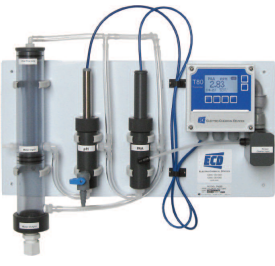
What is chlorine and why is it used?
Before learning about total chlorine analyzers, let’s define what chlorine is. Chlorine is a diatomic gaseous element that is a strong oxidizer (wants electrons). The high oxidation potential makes it an efficient sanitizer and disinfectant. When combined with water it hydrolyzes to form hypochlorous acid and hypochlorite ion, depending on the pH.
Chlorine-based disinfectants provide a more potent residual effect than other disinfectants; therefore, they play a vital role in distribution networks and are the disinfectant of choice for drinking water plants. Chlorine disinfects water by killing or deactivating many pathogens that lead to disease, such as E. coli, Hepatitis, and Giardia.
What is total chlorine?
- Total chlorine – is the sum of free chlorine and combined chlorine in the sample.
- Free Chlorine – is the amount of chlorine in the water available to sanitize and kill harmful bacteria, viruses, and other pathogens.
- Combined Chlorine – is formed by the reaction of free chlorine with organic compounds, such as ammonia or other nitrogen compounds.
How do chlorine analyzers measure total chlorine?
There are two accepted methods that total chlorine analyzers use: colorimetric (photometric) and amperometric (electrochemical).
Colorimetric analyzers require chemical reagents to be added to water. When the reagents are introduced, a color change occurs that is proportional to the concentration of the chlorine present in the water. The resulting color is measured photometrically to determine the chlorine level. Amperometric analyzers measure the electric current changes across two electrodes (anode and cathode) which result from a chemical reaction taking place at the electrodes. The resulting electrical current is proportional to the concentration of the analyte (HOCL), or the hypochlorous acid. These are very basic descriptions.
What industries measure total chlorine?
A major industry for total chlorine measurement is in the water/wastewater industry. Wastewater plants discharge water into lakes, rivers, streams, etc., because of where they discharge their water there are governmental regulations imposed on the effluent flow. Many wastewater plants need to meet permit requirements on the total residual chlorine to ensure the receiving body of water will retain a safe chlorine level since any form of chlorine can be highly toxic to aquatic life. Total chlorine is used because this measurement accounts for both free and combined chlorine. Another contributing factor is that chlorine chemicals are expensive, so optimization of the chlorination process is beneficial.
